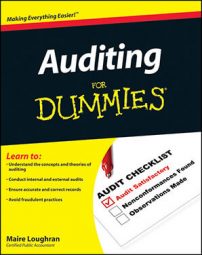Your audit client will prepare bank reconciliations, which compare and adjust its cash balance per its bank statements with its book cash balances. When you audit the bank reconciliations, you must make sure your client adjusts for three things:
Deposits in transit, which are deposits the company makes that haven’t appeared on the bank statement yet.
Outstanding checks, which are checks the company has written that haven’t yet cleared the bank account.
Account charges, which include any bank charges and customer or vendor electronic transfers shown on the bank statements that haven’t yet been recorded.
Your job is to check your client’s bank reconciliations to make sure it has recorded the correct amount of cash on the balance sheet. If your client doesn’t show correct cash balances on its books, the client may have misstated revenue or expenses. This audit procedure should be fairly easy to do:
Get a bank confirmation to verify ending bank account balances.
This confirmation also asks the bank to disclose any loan(s) the client has with the bank, which will come in handy when you confirm liabilities.
Get a cutoff bank statement showing transactions that hit your audit client’s bank statement for the 7- to 10-day period after the end of the financial period.
Trace all deposits clearing on the cutoff statement to the client’s bank reconciliation. Also, check all checks clearing on the cutoff statement to the outstanding checks on the client’s bank reconciliation.
Discuss any differences between the cutoff statement and the bank reconciliations with client management.
You may have to give the client an adjusting entry to correct mistakes. For example, if a deposit in transit didn’t clear on the cutoff statement, it most likely wasn’t received by the client by year-end. The adjustment probably will result in a reduction to revenue.
Make sure all adjusted bank balances agree with what your client reflects on the balance sheet.
The adjusted bank balance is the actual amount of cash in the account. Make sure the client hasn’t neglected to journalize any corrections to bring the book value of cash to actual.

